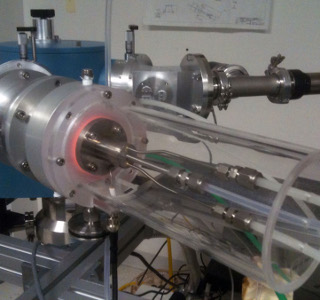
Windowless Hollow Cathode
The Model 629 Hollow Cathode is a CW gas discharge source used to ionize molecular or rare gases. It operates with no window and is a rich source of ion lines at wavelengths longer than 25 nm (less than 50 eV). Output line emission depends on the gases used. It is possible to mix or switch gases during operation. It is electrically quiet and features a water cooled anode and cathode. A differential pumping accessory is available to limit the gas load into the spectrometer. Commercial grade gases are generally used and selection may depend on your application. The source body has a port for directly monitoring gas pressure in the discharge.
Source operation requires a 2 kV 500 mA current regulated power supply like the McPherson Model 730
| Source | Gas discharge |
| Wavelength range | 25nm to Visible |
| Flux in bright lines | ~10E8 photons/second |
| Source Emission | Ionized gas emission lines |
| Emission uniformity | ~12 degree cone angle |
| Power Supply | 0.5 A 2000 VDC required sold separate (see Model 730) |
| Requires | Cooling water, gas (He, Ne, Ar, etc.) and 0.5 A at 2000 VDC |
| Starting pressure | 0.5 - 1 torr |
| Operating pressure | 200 - 400 microns |
| Size | approximately cylindrical, 6" diameter x 13" long |
| Weight | 8 lbs |